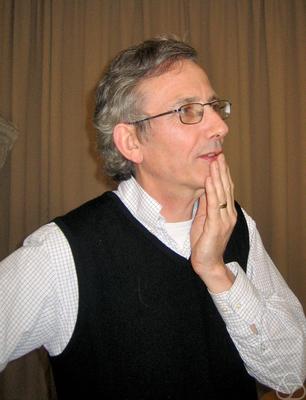
Edward Witten is an American mathematical and theoretical physicist. He is a professor emeritus in the school of natural sciences at the Institute for Advanced Study in Princeton. Witten is a researcher in string theory, quantum gravity, supersymmetric quantum field theories, and other areas of mathematical physics. Witten's work has also significantly impacted pure mathematics. In 1990, he became the first physicist to be awarded a Fields Medal by the International Mathematical Union, for his mathematical insights in physics, such as his 1981 proof of the positive energy theorem in general relativity, and his interpretation of the Jones invariants of knots as Feynman integrals. He is considered the practical founder of M-theory.

Sir Simon Kirwan Donaldson is an English mathematician known for his work on the topology of smooth (differentiable) four-dimensional manifolds, Donaldson–Thomas theory, and his contributions to Kähler geometry. He is currently a permanent member of the Simons Center for Geometry and Physics at Stony Brook University in New York, and a Professor in Pure Mathematics at Imperial College London.
In mathematics, the Property P conjecture is a statement about 3-manifolds obtained by Dehn surgery on a knot in the 3-sphere. A knot in the 3-sphere is said to have Property P if every 3-manifold obtained by performing (non-trivial) Dehn surgery on the knot is not simply-connected. The conjecture states that all knots, except the unknot, have Property P.
In mathematics, a 4-manifold is a 4-dimensional topological manifold. A smooth 4-manifold is a 4-manifold with a smooth structure. In dimension four, in marked contrast with lower dimensions, topological and smooth manifolds are quite different. There exist some topological 4-manifolds which admit no smooth structure, and even if there exists a smooth structure, it need not be unique.
In mathematics, Khovanov homology is an oriented link invariant that arises as the cohomology of a cochain complex. It may be regarded as a categorification of the Jones polynomial.
In mathematics, Floer homology is a tool for studying symplectic geometry and low-dimensional topology. Floer homology is a novel invariant that arises as an infinite-dimensional analogue of finite-dimensional Morse homology. Andreas Floer introduced the first version of Floer homology, now called Lagrangian Floer homology, in his proof of the Arnold conjecture in symplectic geometry. Floer also developed a closely related theory for Lagrangian submanifolds of a symplectic manifold. A third construction, also due to Floer, associates homology groups to closed three-dimensional manifolds using the Yang–Mills functional. These constructions and their descendants play a fundamental role in current investigations into the topology of symplectic and contact manifolds as well as (smooth) three- and four-dimensional manifolds.

Ciprian Manolescu is a Romanian-American mathematician, working in gauge theory, symplectic geometry, and low-dimensional topology. He is currently a professor of mathematics at Stanford University.
Peter Benedict Kronheimer is a British mathematician, known for his work on gauge theory and its applications to 3- and 4-dimensional topology. He is William Caspar Graustein Professor of Mathematics at Harvard University and former chair of the mathematics department.
In mathematics, a smooth algebraic curve in the complex projective plane, of degree , has genus given by the genus–degree formula

Clifford Henry Taubes is the William Petschek Professor of Mathematics at Harvard University and works in gauge field theory, differential geometry, and low-dimensional topology. His brother is the journalist Gary Taubes.
The Oswald Veblen Prize in Geometry is an award granted by the American Mathematical Society for notable research in geometry or topology. It was funded in 1961 in memory of Oswald Veblen and first issued in 1964. The Veblen Prize is now worth US$5000, and is awarded every three years.
In mathematics, and especially gauge theory, Donaldson theory is the study of the topology of smooth 4-manifolds using moduli spaces of anti-self-dual instantons. It was started by Simon Donaldson (1983) who proved Donaldson's theorem restricting the possible quadratic forms on the second cohomology group of a compact simply connected 4-manifold. Important consequences of this theorem include the existence of an Exotic R4 and the failure of the smooth h-cobordism theorem in 4 dimensions. The results of Donaldson theory depend therefore on the manifold having a differential structure, and are largely false for topological 4-manifolds.
John Willard Morgan is an American mathematician known for his contributions to topology and geometry. He is a Professor Emeritus at Columbia University and a member of the Simons Center for Geometry and Physics at Stony Brook University.
In knot theory, the Milnor conjecture says that the slice genus of the torus knot is
The Geometry Festival is an annual mathematics conference held in the United States.
In mathematics, the Kronheimer–Mrowka basic classes are elements of the second cohomology of a simply connected, smooth 4-manifold of simple type that determine its Donaldson polynomials. They were introduced by Peter B. Kronheimer and Tomasz S. Mrowka.
Robert Ernest Gompf is an American mathematician specializing in geometric topology.
Daniel Bennequin is a French mathematician, known for the Thurston–Bennequin number introduced in his doctoral dissertation.
Ronald Alan Fintushel is an American mathematician, specializing in low-dimensional geometric topology and the mathematics of gauge theory.
The Joseph L. Doob Prize of the American Mathematical Society (AMS) awards $5,000 (U.S.) every three years for "a single, relatively recent, outstanding research book that makes a seminal contribution to the research literature, reflects the highest standards of research exposition, and promises to have a deep and long-term impact in its area." The prize, endowed in 2005 by Paul and Virginia Halmos, is named in honor of AMS President Joseph L. Doob, who was Paul Halmos's doctoral advisor in the department of mathematics at the University of Illinois. According to Paul Halmos, "Doob was the first well-informed modern mathematician in the department". In order for a mathematical research book to be eligible for the prize, it must have been published within the past 6 calendar years of the year of its nomination. The prize was originally named the AMS Book Prize, but after the first award was renamed the Doob Prize.




